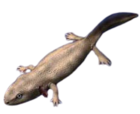| Potamotyphlus kaupii | |
|---|---|

| |
| Scientific classification | |
| Domain: | Eukaryota |
| Kingdom: | Animalia |
| Phylum: | Chordata |
| Class: | Amphibia |
| Order: | Gymnophiona |
| Clade: | Apoda |
| Family: | Typhlonectidae |
| Genus: | Potamotyphlus Taylor, 1968 |
| Species: | P. kaupii
|
| Binomial name | |
| Potamotyphlus kaupii (Berthold, 1859)
| |

| |
Potamotyphlus kaupii (also known as Kaup's caecilian) is a species of amphibian in the family Typhlonectidae. It is monotypic within the genus Potamotyphlus. It is found widely in the Amazon Basin and the Guianas in South America,[2] and is known to occur in Brazil, Colombia, Ecuador, Peru, Venezuela, and possibly Bolivia.[1] It is an entirely aquatic species and typically ranges between 30 and 60 cm (12–24 in) in length.[3]
Their most common causes of death are dermatitis and skin lesions. The chytrid fungus Batrachochytrium dendrobatidis, can also threaten them, as it does to many other amphibian biodiversity all over the world.[4]
References
- ^ a b Mark Wilkinson; John Measey; Enrique La Marca; Luis A. Coloma; Santiago Ron & Fernando Castro (2010). "Potamotyphlus kaupii". IUCN Red List of Threatened Species. 2010: e.T59589A11955756. doi:10.2305/IUCN.UK.2010-2.RLTS.T59589A11955756.en. Retrieved 14 November 2021.
- ^ Oliveira; Meneghell; Messias; Gomes; and Coragem (2012). First Record of Potomotyphlus kaupii (Berthold, 1859) (Gymnophiona: Typhlonectidae) for the state of Rondônia, Brazil. Herpetology Notes 5: 155-156
- ^ Vitt, L.J.; and Caldwell, J.P. (2013). Herpetology, Fourth Edition: An Introductory Biology of Amphibians and Reptiles, p. 453. ISBN 978-0-12-386919-7
- ^ Flach, E. J., et al. Postmortem Findings in Eight Species of Captive Caecilian (Amphibia: Gymnophiona) Over a Ten-Year Period. 50 Vol. Lawrence, Kan. : American Association of Zoo Veterinarians, 2020. Web.





